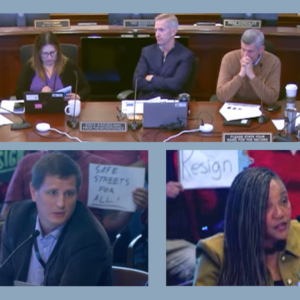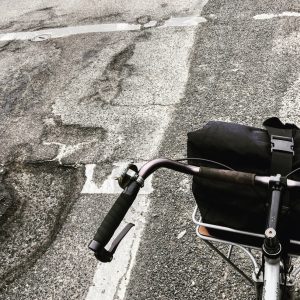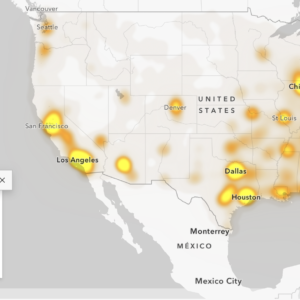Here is the complete text of a letter sent from City Commissioner Sam Adams about the budget crisis at PDOT (read the full story on the Front Page):
Friends,
I want you to be aware of impacts of massive new transportation challenge facing our City.
Gas prices are up 17%.
Bio-diesel is up 20%.
Yesterday, crude oil went for a record $120 a barrel.
You feel the impact on your household budget of these higher fuel prices. So does the Portland Office of Transportation (PDOT), although in a different way than Portland families do.
The first way PDOT is feeling the pinch of increased oil prices is a new multi-million dollar transportation department budget gap. Why? Oregonians are driving less, in part due to the cost of gas. PDOT’s funding for taking care of local streets and bridges comes largely from state fuel taxes. The gas tax is based on the number of gallons of gas sold – not the price of that gas. So, the fewer gallons of gas sold, the less gas tax. For PDOT that means a $2.7 million current service budget hole for the fiscal year starting in July.
Second, the skyrocketing cost of oil has put existing estimates for transportation projects out-of-whack. PDOT has about 40 projects in the pipeline for delivery in the next two years. Most of these projects used inflationary cost estimates that have proven to be low. Higher costs for petroleum–based materials like asphalt and tar and for materials that take lots of energy to produce like concrete and steel mean higher project costs.
In response, to protect basic transportation services like street sweeping, pothole repair and bridge maintenance, I will be asking the Portland City Council to fill the $2 million budget shortfall for next year. And, I have ordered a 30-day review of the cost estimates in PDOT’s project pipeline.
If these trends continue, this ongoing budget shortfall also blows a $30 to $40 million hole in the proposed Safe, Sound and Green Street Initiative budget that I have slated to go to the voters in November 2008.
Finally, I have also cancelled the Sauvie Island bridge reuse project. I simply do not feel confident that we can bring this project in at the $5.5 million budget I have promised. To insure the integrity of the project, I asked for a rigorous review by transportation staff and outside engineers. On Tuesday morning, it became clear that the $5.5 million budget for reusing the Sauvie Island bridge could no longer be guaranteed. I will continue to pursue the construction of a new cheaper bridge over I-405 within the next three to five years.
I believe that cancelling this project is the right thing to do given the new financial estimates we have received over the past couple of days. But I want to make some comments about the bridge project before we leave the issue.
The recycling of the Sauvie Island bridge was sadly–and unnecessarily–ensnared by political gamesmanship that did no credit to the critics, and obscured an important issue for the public.
Last week, Mayor Tom Potter wrote an opinion article in these pages saying that we don’t need a bicycle/pedestrian bridge over I-405 at Flanders Street. Mind you, this is a project that he voted for on 4 separate occasions. In fact, over the last six years two city councils have voted for this numerous times.
But in his article, Mayor Potter argues that the West Burnside and Northwest Everett and Glisan streets are safe and that bikers and walkers in Northwest Portland do not need a bridge dedicated only to them across the I-405 ditch.
That’s flat out wrong. The West Burnside, Glisan and Everett streets injure and kill more bikers and walkers than any other street corridor in Portland: 280 injured and 15 dead over the past nine years. And I believe the Mayor was also wrong to use this issue to pit one part of Portland against the other.
In my three years as transportation commissioner I have lead the council to focus on the top safety issues in each part of Portland, including:
- $11 million in city non-transportation funds to fund transportation safety projects, 76% of those projects are along East 122nd and East 82nd avenues – two of the most dangerous street corridors in Portland.
- $5 million in regional funds to build three east Portland bridges to connect the Springwater Trail;
- $11 million in regional funds to build and pedestrian and bridge over I-5 to connect the South hills to Willamette River;
- and, $5.4 million in regional, city, and non-transportation funds to build sidewalks along NE Cully Blvd.
When it comes to saving lives and preventing injuries, I believe that projects should be approved on the merits, community support and a clear picture of the budget. That is why everyone but Mayor Potter supported the Flanders Street bridge: it met all the criteria that we have used to put safety first.
A bike and pedestrian crossing at NW Flanders has always been about safety. And while recycling the Sauvie Island Bridge may not be the means, I am committed to finding a safe way for pedestrians and bicyclists to cross I-405. I have asked transportation to study potential improvements we could make with little cost to address safety issues in the Burnside/Everett/Glisan corridor in the short term.
I want to thank all of those who’ve supported the vision for this project.
For more information on the actions we’re taking in light of the budget shortfalls and increased costs in transportation, visit http://www.commissionersam.com/node/3682.
My best,
Sam






Thanks for reading.
BikePortland has served this community with independent community journalism since 2005. We rely on subscriptions from readers like you to survive. Your financial support is vital in keeping this valuable resource alive and well.
Please subscribe today to strengthen and expand our work.
\”The West Burnside, Glisan and Everett streets injure and kill more bikers and walkers than any other street corridor in Portland: 280 injured and 15 dead over the past nine years.\” Sam Adams
I don\’t remember those figures being associated with the Glisan and Everett crossings. Does anyone know where he got them?
I would have liked to ask Adams if Kuney, given the opportunity, would have guaranteed the entire Flander\’s Crossing with the Sauvie Isl span at $5.5 million.